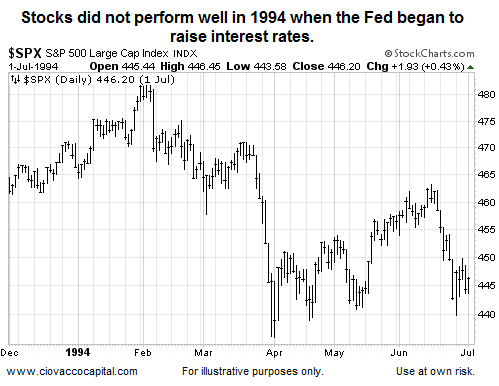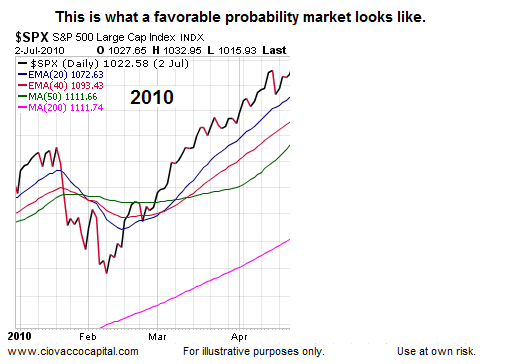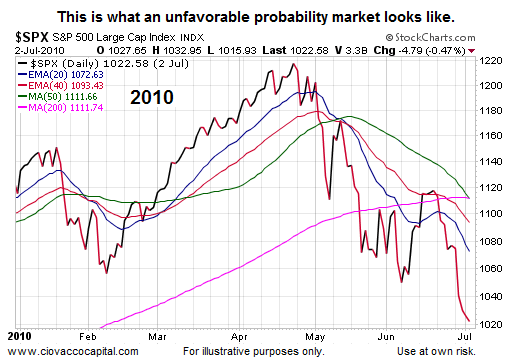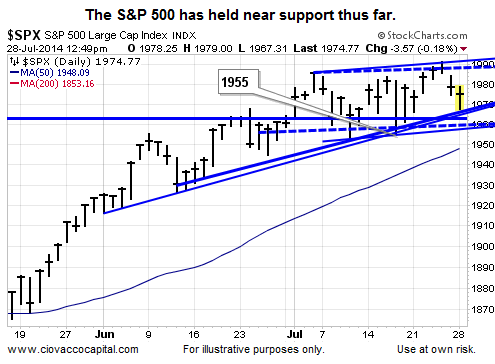Lessons From 1994
If you were investing in 1994, you probably recall it was a difficult year. Notice the similarities to 2014 in the text from The Economist below:
CAST your minds back to 1994. The Federal Reserve had kept rates at (what seemed then) the low level of 3% for three years in an effort to allow the financial sector industry to recover from the savings & loan crisis, a problem that was the result of reckless expansion and lending (thank goodness they learned the lessons of that disaster). The Fed then started very modestly to tighten monetary policy with a quarter point rate increase. But the bond market had its worst year since the late 1920s.
As interest rates began to rise in 1994, stock investors began to become concerned about the possible negative impact on the economy and earnings.

What Could Kick Off A Correction?
It could be any number of things, including a shift in Fed policy, rising inflation, or weak economic data. It is more likely that a stock market correction will be ushered in based on numerous factors. This week brings a few potential catalysts: GDP and a Fed statement Wednesday and a monthly labor report Friday.
What Does A Healthy Market Look Like?
If we understand what extreme cases look like, it is much easier to discern between normal volatility and something that may morph into a more serious and prolonged correction. Not too many bad things can happen as long as the S&P 500 remains above the moving averages shown in the chart below.

What Does A Correction Look Like?
If we compare and contrast the chart above and the chart below, we can see they are quite a bit different. Warning signs were visible in early May 2010. Stocks did not bottom until early July 2010. If you are skeptical, this video walks through the 2010 chart step by step, showing observable shifts that occurred early in the corrective process.

Housing Data Met With Early Selling
Monday morning was dominated by sellers after a worse than expected report on housing. From Bloomberg:
Stocks slumped earlier in the day as fewer Americans than forecast signed contracts to buy previously owned homes in June, a sign residential real estate is struggling to strengthen. An S&P index of homebuilder shares dropped 1.6 percent to the lowest level since May.
Investment Implications
It is not possible for the S&P 500 to enter a multi-week or multi-month correction without closing below 1955. On Monday afternoon, the index was trading at 1980, or well above 1955.

Since the S&P 500 was basically flat at press time on Monday, the statements below from July 26 still apply:
It is fair to say we remain about 80% confident and 20% concerned about equities. While the 80% figure is still encouraging, it is not as high as it was even a week ago. Therefore, we continue to hold U.S. stocks (ARCA:SPY) and leading sectors, such as transportation (ARCA:IYT). However, we reduced our stock exposure Friday and took a relatively small stake in bonds (ARCA:TLT). Since rising rates are a concern, we kept some powder dry in the form of cash.
Part of the 80% confident is based on the fact that the S&P 500 is still trading above all the moving averages shown in the 2010 charts above. At some point, the evidence will begin to shift. It is not necessary to try to guess or anticipate when a correction will begin. When the evidence changes, we will make the necessary adjustments.
